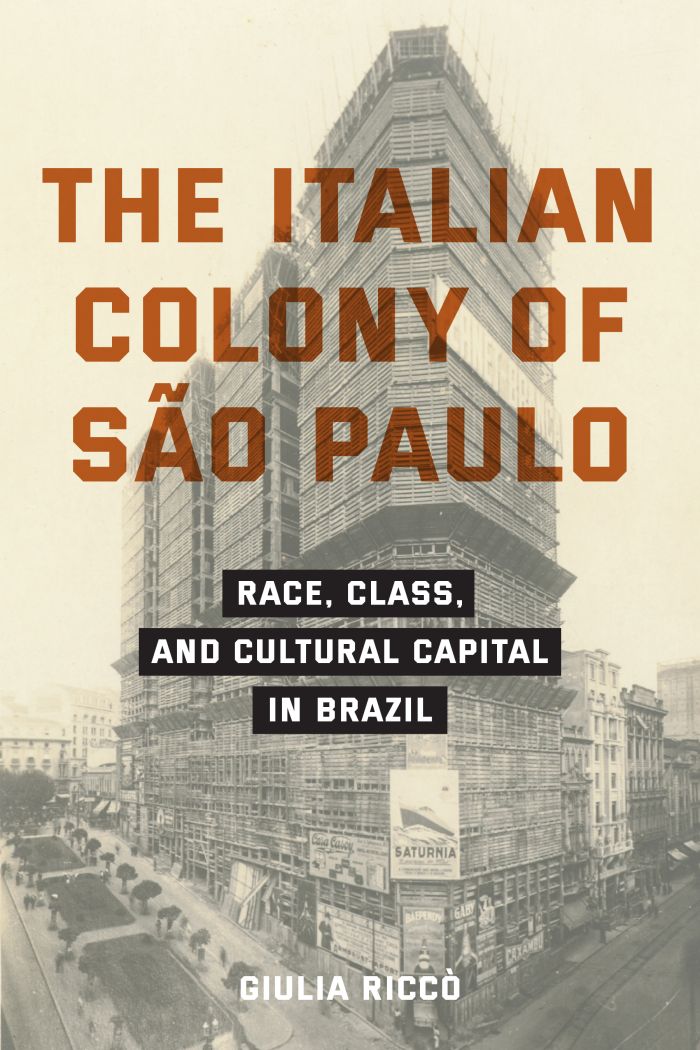Save 25% plus free shipping during our Winter Sale! Use promo code JOY2025. Expires 1/5/26.
The Italian Colony of São Paulo
Race, Class, and Cultural Capital in Brazil

This book can be opened with

WINNER, 2024 ALDO AND JEANNE SCAGLIONE PUBLICATION AWARD FOR A MANUSCRIPT IN ITALIAN LITERARY STUDIES, MODERN LANGUAGES ASSOCIATION
Introduces a way to study migration that privileges literary analysis over and against sociological data and insists on the importance of culture in the production of political identities
This book argues that Italians first became racialized as white in São Paulo, Brazil, at the turn of the twentieth century. Whereas Italians in the United States struggled with xenophobia and were often not fully acknowledged as white, in São Paulo, due to a series of social, economic, and cultural factors, Italians became closely associated with ideas of whiteness, modernization, and civilization. This book brings to light how the overlooked experiences of Italians in Brazil complicate conventional narratives about the racial ambiguity and oppression of Italians in the Americas, on the one hand, and the conflation of Italians with cultural and economic backwardness in Europe, on the other.
In the book, close readings of a wide array of texts—the travel writings of Gina Lombroso Ferrero, the short stories of Antônio de Alcântara Machado, the columns of José Correia Leite, the political essays of Miguel Reale, and the memoirs of Zélia Gattai—trace a “New World Italian discourse,” or the overlapping narratives about Italian racial, economic, and cultural superiority that constructed and maintained Italians’ status as a model minority in São Paulo. These discursive practices represent essential antecedents to the racial nationalism that reared its ugly head in Italy throughout the twentieth century and remain central to contemporary debates about national identity in the Italian public sphere.
The Italian Colony of São Paulo: Race, Class, and Cultural Capital in Brazil is available from the publisher on an open-access basis.
The Italian Colony of São Paolo is a groundbreaking study of Italian immigration to Brazil and the formation of Italian ethnic identity within a multiracial society marked by a large Black population and a legacy of plantation slavery. Giulia Riccò draws on a rich array of voices—including elite Italian travelers, literary modernists, working-class Black Brazilians living alongside Italians, middle-class Italo-Brazilians with fascist leanings, and labor-oriented working-class Italo-Brazilians. She shows that Italians in Brazil succeeded in positioning themselves as exemplars of Mediterranean whiteness, in contrast to Italians in the United States, who often faced stigmatization due to their imagined closeness to Blackness.—Christopher Dunn, Tulane University, author of Contracultura: Alternative Arts and Social Transformation in Authoritarian Brazil
The Italian Colony of São Paulo offers illuminating perspectives on the Italian presence in Brazil, on the wider history of Italian migration, and on what that history can tell us about racial politics in a variety of locations, including Italy and the United States. With originality and analytical depth, the author delivers a powerful critique of ethnicity and its politics, significantly enriching and repositioning the growing body of work on Italians in the Americas.—Loredana Polezzi, Stony Brook University
Introduction: São Paulo, Nova York da Sul America:
Italian Immigrants in São Paulo and the Making of Modern Brazilian Culture | 1
1. Tutto è italiano: Gina Lombroso Ferrero and the Cultivation of Italian São Paulo | 22
2. Cidadão italiano residente em São Paulo: Modernism, Cannibalism, and the Italians of São Paulo | 50
3. I perchè nu so naziunale? José Correia Leite, Blackness, and New World Italians | 77
4. Sob o signo da Dante: Miguel Reale, Italianness, and Fascism | 108
5. Muito parecida mas completamente diferente: Zélia Gattai,
Multidirectionality, and the Italian Anarchists | 135
Coda: Whose Italianness? | 167
Acknowledgments | 175
Notes | 181
Bibliography | 227
Index | 247
Please click the link below to download the Open Access version of this book.




